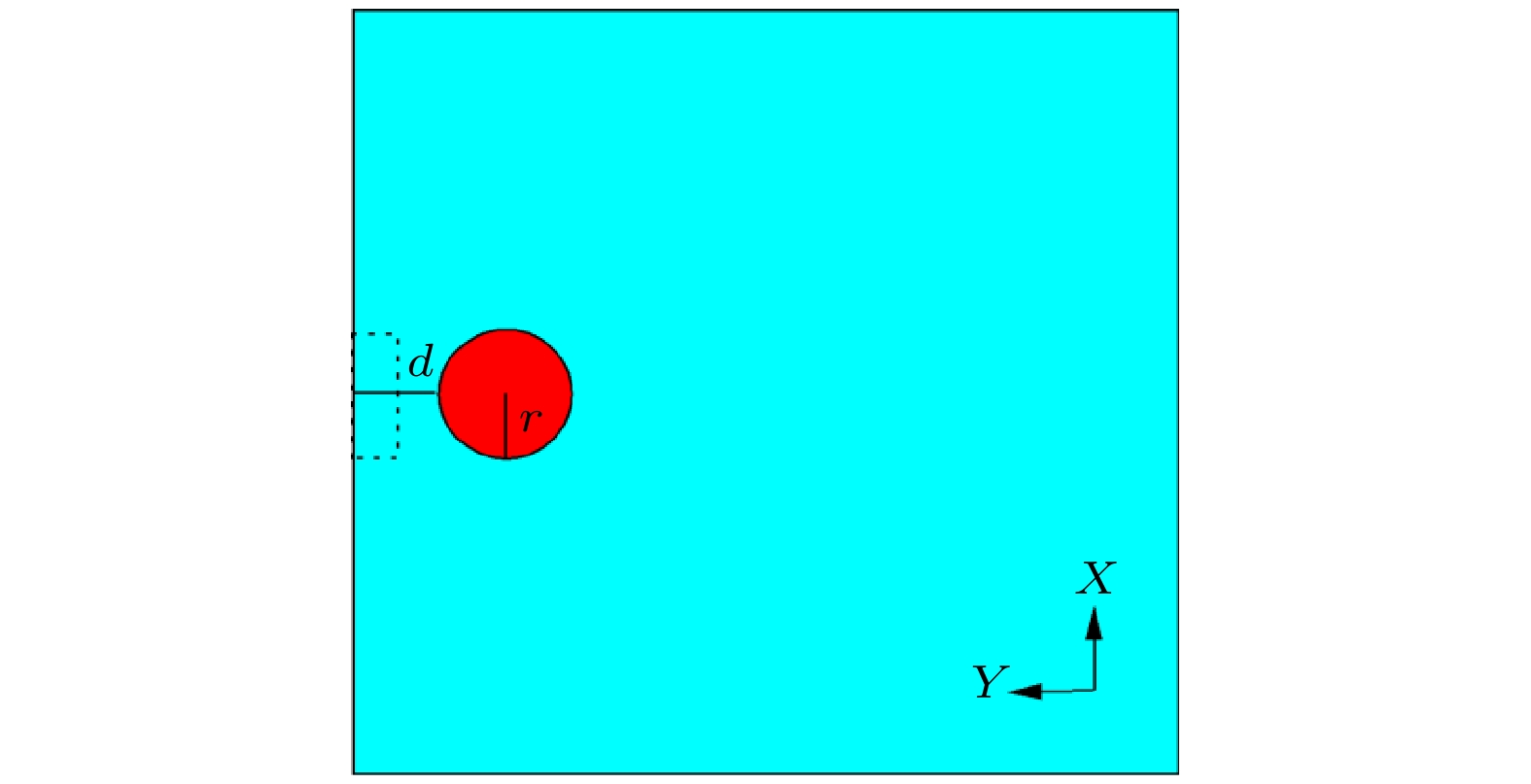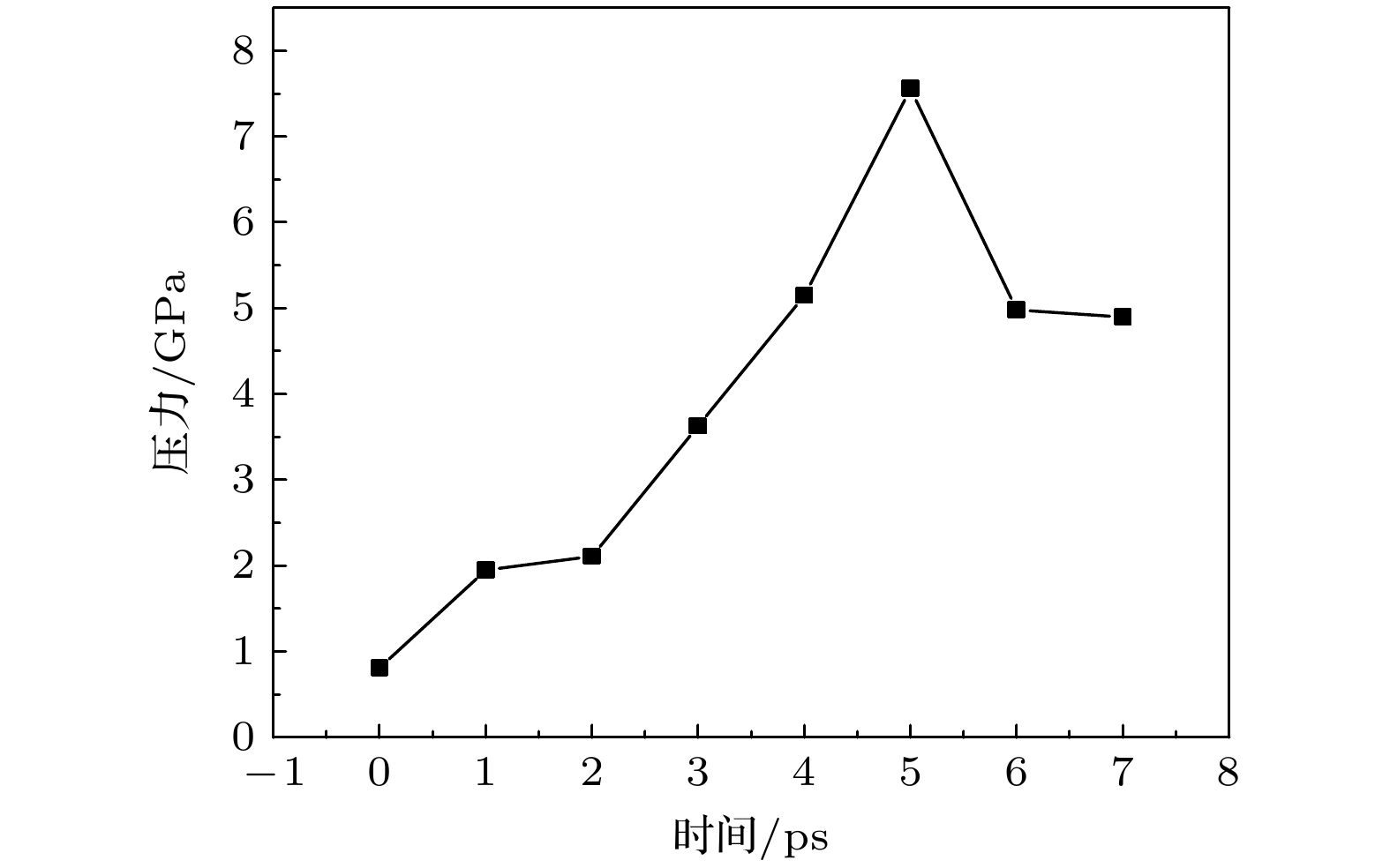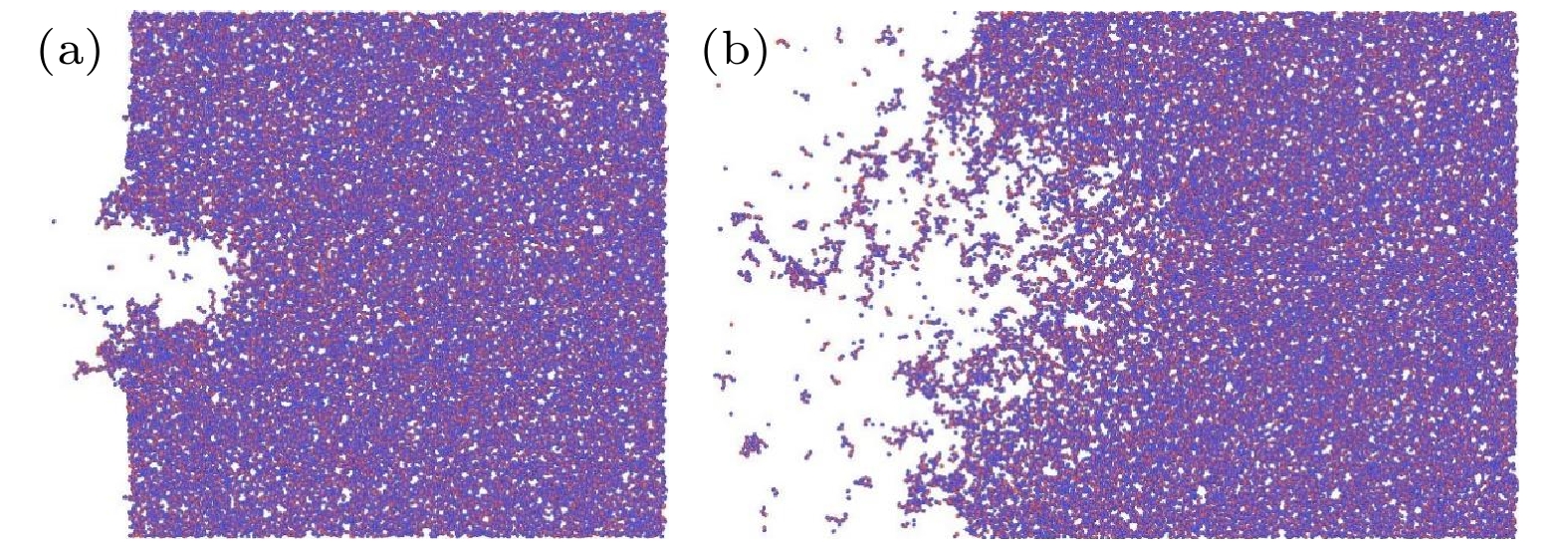-
Fused silica optical element is the core component of the inertial confinement nuclear fusion ignition device. Due to the requirement of ignition conditions of the device for high power laser, the damage to fused silica optical element under strong laser is the key to restricting the operation of the ignition device. Therefore, the study of the surface damage of fused silica irradiated by laser is crucial to the development of the ignition device for inertial confinement nuclear fusion. In this paper, large-scale non-equilibrium molecular dynamics simulation method and micro-structure analysis technology suitable for dynamic process are proposed to study the damage process of fused silica surface under laser loading. Based on the theoretical study of high-temperature plasma fireball model, the damage of high-temperature fused silica plasma ball to surface is simulated. By tracking the local structure, temperature distribution and surface morphology, the factors affecting the surface damage of fused silica are analyzed. Our research results show that the size, distance from the surface, and temperature of high-temperature fused silica balls have important effects on the surface damage. We find that there are two different damage modes under the combined effect of the above factors. One is related to a rapid damage process, generating U-shaped voids and no further obvious damages after the surface spraying, and the other is dependent of a slow damage process: continuously expanding and resulting in a larger damage area. The surface morphologies formed by these two damage modes are consistent with the two typical damage morphologies observed in the experiments. This research can provide a guidance for understanding the complex damage process in fused silica under laser irradiation.
-
Keywords:
- laser irradiation damage /
- fused silica /
- molecular dynamics
[1] Chen Q, Wang H, Dai R, Wang Z, Tao X, Zhao W, Zhang Z 2021 Laser Part. Beams 2021 6
 Google Scholar
Google Scholar
[2] Bude J, Guss G, Matthews M, Spaeth M L 2007 Proc. SPIE 6720 672009
 Google Scholar
Google Scholar
[3] Chai X X, Li P, Zhao J P, Wang G Z, Zhu D Y, Jiang Y L, Chen B, Zhu Q H, Feng B, Wang L Q, Jing Y K 2020 Optik 226 165549
 Google Scholar
Google Scholar
[4] Zhang Y, Song C, Shi F, Tian Y, Lin Z 2020 Proc. SPIE 11427 1142745
 Google Scholar
Google Scholar
[5] Schaffer C B, Brodeur A, Mazur E 2001 Meas. Sci. Technol. 12 1784
 Google Scholar
Google Scholar
[6] Li B, Hou C Y, Tian C X, Guo J L, Xiang X, Jiang X L, Wang H J, Liao W, Yuan X D, Jiang X D, Zu X T 2020 Appl. Surf. Sci. 508 145186
 Google Scholar
Google Scholar
[7] Tan C, Zhao L J, Chen M J, Cheng J, Yin Z Y, Liu Q, Yang H, Liao W 2021 J. Non-Cryst. Solids 558 120662
 Google Scholar
Google Scholar
[8] Bercegol H, Boscheron A, Di-Nicola J M, Journot E, Lamaignere L, Neauport J, Raze G 2008 J. Phys.: Conf. Ser. 112 032013
 Google Scholar
Google Scholar
[9] Shen X, Feng G Y, Jing S, Han J H, Li Y G, Liu K 2019 Chin. Phys. B 28 085202
 Google Scholar
Google Scholar
[10] 韩伟, 冯斌, 郑奎兴, 朱启华, 郑万国, 巩马理 2016 65 246102
 Google Scholar
Google Scholar
Han W, Feng B, Zheng K X, Zhu Q H, Zheng W G, Gong M L 2016 Acta Phys. Sin. 65 246102
 Google Scholar
Google Scholar
[11] Carr C W, Bude J D, DeMange P 2010 Phys. Rev. B 82 184304
 Google Scholar
Google Scholar
[12] Carr C W, Radousky H B, Rubenchik A M, Feit M D, Demos S G 2004 Phys. Rev. Lett. 92 087401
 Google Scholar
Google Scholar
[13] Demange P, Negres R, Raman R, Colvin J, Demos S 2011 Phys. Rev. B 84 054118
 Google Scholar
Google Scholar
[14] Demos S G, Raman R N, Negres R A 2013 Opt. Express 21 4875
 Google Scholar
Google Scholar
[15] Dijon J, Poiroux T, Desrumaux C 1997 Proc. SPIE 2966 315
 Google Scholar
Google Scholar
[16] Feit M D, Rubenchik A M 2003 Mechanisms of CO2 Laser Mitigation of Laser Damage Growth in Fused Silica (Livermore, CA: Lawrence Livermore National Lab.) Report Number. UCRL-JC-148580
[17] Jiang Y, Liu H F, Zhang F W, Zhang B J, Liao W, Zhang L J, Wang H J, Qiu R, Guo D C, Zhou Q, Yao C Z 2021 Fusion Eng. Des. 173 112956
 Google Scholar
Google Scholar
[18] Yan C Y, Liu B A, Li X C, Liu C, Ju X 2020 Chin. Phys. B 29 27901
 Google Scholar
Google Scholar
[19] Wang H X, Wang C, Zhang M Z, Zheng E M, Chen X H 2019 Appl. Opt. 58 9839
 Google Scholar
Google Scholar
[20] 郭洪岩, 刘全喜 2018 激光与红外 48 958
 Google Scholar
Google Scholar
Guo H Y, Liu Q X 2018 Laser Infrared 48 958
 Google Scholar
Google Scholar
[21] Wang Q S, Jiang L, Sun J P, Pan C J, Han W N, Wang G Y, Zhang H, Grigoropoulos C P, Lu Y F 2017 Photonics Res. 5 488
 Google Scholar
Google Scholar
[22] Kubota A, Caturla M J, Stolken J S, Feit M 2001 Opt. Express 8 611
 Google Scholar
Google Scholar
[23] Sugiura H, Ikeda R, Kondo K, Yamadaya T 1997 J. Appl. Phys. 81 1651
 Google Scholar
Google Scholar
[24] Su R, Xiang M Z, Chen J, Jiang S L, Wei H 2014 J. Appl. Phys. 115 193508
 Google Scholar
Google Scholar
[25] Shen R Q, Bai Q S, Li Y H, Guo Y B, Zhang F H 2020 J. Appl. Phys. 127 245114
 Google Scholar
Google Scholar
[26] Dyachkov S, Parshikov A, Zhakhovsky V 2015 19th Biennial Conference of the APS Topical Group on Shock Compression of Condensed Matter Tampa, USA, June 14–19, 2015 p100024
[27] Li B, Zhao F P, Wu H A, Luo S N 2014 J. Appl. Phys. 115 349
[28] Plimpton S 1995 Comput. Mater. Sci. 4 361
 Google Scholar
Google Scholar
[29] Munetoh S, Motooka T, Moriguchi K, Shintani A 2007 Comput. Mater. Sci. 39 334
 Google Scholar
Google Scholar
[30] Thompson A P, Plimpton S J, Mattson W 2009 J. Chem. Phys. 131 154107
 Google Scholar
Google Scholar
[31] Stukowski A 2010 Modell. Simul. Mater. Sci. Eng. 18 015012
 Google Scholar
Google Scholar
[32] Barmes F, Soulard L, Mareschal M 2006 Phys. Rev. B 73 224108
 Google Scholar
Google Scholar
[33] Mozzi R, Warren B 1969 J. Appl. Crystallogr. 2 164
 Google Scholar
Google Scholar
[34] Wong J, Ferriera J L, Lindsey E F 2006 J. Non-Cryst. Solids 352 255
 Google Scholar
Google Scholar
[35] Miller P E, Bude J D, Suratwala T I, Shen N, Laurence T A, Steele W A, Menapace J, Feit M D, Wong L L 2010 Opt. Lett. 35 2702
 Google Scholar
Google Scholar
[36] Neauport J, Lamaignere L, Bercegol H 2005 Opt. Express 13 10163
 Google Scholar
Google Scholar
-
图 1 熔石英初始模型的二维示意图, 红色区域温度T = 10000 K, 浅蓝色区域T = 300 K, r表示高温熔石英球的半径, d表示球面和熔石英表面之间的距离
Figure 1. A two-dimensional schematic diagram of the initial model of fused silica, with a temperature of 10000 K in the red area and 300 K in the light blue area. r represents the radius of the high-temperature fused quartz sphere, and d represents the distance between the sphere and the surface of the fused silica.
图 3 样品不同时刻微观形貌的切面图, 颜色是根据温度来上色的, 与图2描述的是同一过程(高温球T = 10000 K, r = 20 Å, d = 15 Å)
Figure 3. Cross-sectional view of the microstructure of the sample at different times is colored based on temperature, which is the same process as described in Fig. 2 (high temperature ball T = 10000 K, r = 20 Å, d = 15 Å).
图 5 高温球T = 10000 K, (a) r = 20 Å, d = 15 Å, (b) r = 20 Å, d = 50 Å条件下, 对应样品中减小的原子质量与样品总质量的比(被喷射出的原子质量除以模型的总质量)随时间的变化
Figure 5. Ratio of the mass of reduced atoms in the sample to the total mass of the sample (the mass of ejected atoms divided by the total mass of the model) over time with high-temperature ball T = 10000 K, (a) r = 20 Å, d = 15 Å, (b) r = 20 Å, d = 50 Å.
图 6 高温球初始温度T = 10000 K和距表面距离d = 20 Å对应的熔石英样品发生损伤时表面的压力(a), 温度(b), 喷射出的原子的质量占总样品的比(c)随球半径r的变化
Figure 6. Surface pressure (a), temperature (b), and the ratio of the mass of ejected atoms to the total sample (c) vary with the radius r of the ball when damage occurs to fused silica with the initial temperature of the high-temperature ball T = 10000 K and the distance from the surface d = 20 Å.
图 7 高温球半径r = 20 Å, 距表面的距离d = 20 Å, 初始温度(a) T = 10000 K, (b) T = 8000 K条件下, 对应的熔石英样品发生表面喷射后的形貌图, 红色为硅原子, 蓝色为氧原子
Figure 7. Morphologies of the fused silica sample after surface spraying shows Si atoms in red and O atoms in blue, with high temperature ball r = 20 Å, d = 20 Å and (a) T = 10000 K, (b) T = 8000 K.
-
[1] Chen Q, Wang H, Dai R, Wang Z, Tao X, Zhao W, Zhang Z 2021 Laser Part. Beams 2021 6
 Google Scholar
Google Scholar
[2] Bude J, Guss G, Matthews M, Spaeth M L 2007 Proc. SPIE 6720 672009
 Google Scholar
Google Scholar
[3] Chai X X, Li P, Zhao J P, Wang G Z, Zhu D Y, Jiang Y L, Chen B, Zhu Q H, Feng B, Wang L Q, Jing Y K 2020 Optik 226 165549
 Google Scholar
Google Scholar
[4] Zhang Y, Song C, Shi F, Tian Y, Lin Z 2020 Proc. SPIE 11427 1142745
 Google Scholar
Google Scholar
[5] Schaffer C B, Brodeur A, Mazur E 2001 Meas. Sci. Technol. 12 1784
 Google Scholar
Google Scholar
[6] Li B, Hou C Y, Tian C X, Guo J L, Xiang X, Jiang X L, Wang H J, Liao W, Yuan X D, Jiang X D, Zu X T 2020 Appl. Surf. Sci. 508 145186
 Google Scholar
Google Scholar
[7] Tan C, Zhao L J, Chen M J, Cheng J, Yin Z Y, Liu Q, Yang H, Liao W 2021 J. Non-Cryst. Solids 558 120662
 Google Scholar
Google Scholar
[8] Bercegol H, Boscheron A, Di-Nicola J M, Journot E, Lamaignere L, Neauport J, Raze G 2008 J. Phys.: Conf. Ser. 112 032013
 Google Scholar
Google Scholar
[9] Shen X, Feng G Y, Jing S, Han J H, Li Y G, Liu K 2019 Chin. Phys. B 28 085202
 Google Scholar
Google Scholar
[10] 韩伟, 冯斌, 郑奎兴, 朱启华, 郑万国, 巩马理 2016 65 246102
 Google Scholar
Google Scholar
Han W, Feng B, Zheng K X, Zhu Q H, Zheng W G, Gong M L 2016 Acta Phys. Sin. 65 246102
 Google Scholar
Google Scholar
[11] Carr C W, Bude J D, DeMange P 2010 Phys. Rev. B 82 184304
 Google Scholar
Google Scholar
[12] Carr C W, Radousky H B, Rubenchik A M, Feit M D, Demos S G 2004 Phys. Rev. Lett. 92 087401
 Google Scholar
Google Scholar
[13] Demange P, Negres R, Raman R, Colvin J, Demos S 2011 Phys. Rev. B 84 054118
 Google Scholar
Google Scholar
[14] Demos S G, Raman R N, Negres R A 2013 Opt. Express 21 4875
 Google Scholar
Google Scholar
[15] Dijon J, Poiroux T, Desrumaux C 1997 Proc. SPIE 2966 315
 Google Scholar
Google Scholar
[16] Feit M D, Rubenchik A M 2003 Mechanisms of CO2 Laser Mitigation of Laser Damage Growth in Fused Silica (Livermore, CA: Lawrence Livermore National Lab.) Report Number. UCRL-JC-148580
[17] Jiang Y, Liu H F, Zhang F W, Zhang B J, Liao W, Zhang L J, Wang H J, Qiu R, Guo D C, Zhou Q, Yao C Z 2021 Fusion Eng. Des. 173 112956
 Google Scholar
Google Scholar
[18] Yan C Y, Liu B A, Li X C, Liu C, Ju X 2020 Chin. Phys. B 29 27901
 Google Scholar
Google Scholar
[19] Wang H X, Wang C, Zhang M Z, Zheng E M, Chen X H 2019 Appl. Opt. 58 9839
 Google Scholar
Google Scholar
[20] 郭洪岩, 刘全喜 2018 激光与红外 48 958
 Google Scholar
Google Scholar
Guo H Y, Liu Q X 2018 Laser Infrared 48 958
 Google Scholar
Google Scholar
[21] Wang Q S, Jiang L, Sun J P, Pan C J, Han W N, Wang G Y, Zhang H, Grigoropoulos C P, Lu Y F 2017 Photonics Res. 5 488
 Google Scholar
Google Scholar
[22] Kubota A, Caturla M J, Stolken J S, Feit M 2001 Opt. Express 8 611
 Google Scholar
Google Scholar
[23] Sugiura H, Ikeda R, Kondo K, Yamadaya T 1997 J. Appl. Phys. 81 1651
 Google Scholar
Google Scholar
[24] Su R, Xiang M Z, Chen J, Jiang S L, Wei H 2014 J. Appl. Phys. 115 193508
 Google Scholar
Google Scholar
[25] Shen R Q, Bai Q S, Li Y H, Guo Y B, Zhang F H 2020 J. Appl. Phys. 127 245114
 Google Scholar
Google Scholar
[26] Dyachkov S, Parshikov A, Zhakhovsky V 2015 19th Biennial Conference of the APS Topical Group on Shock Compression of Condensed Matter Tampa, USA, June 14–19, 2015 p100024
[27] Li B, Zhao F P, Wu H A, Luo S N 2014 J. Appl. Phys. 115 349
[28] Plimpton S 1995 Comput. Mater. Sci. 4 361
 Google Scholar
Google Scholar
[29] Munetoh S, Motooka T, Moriguchi K, Shintani A 2007 Comput. Mater. Sci. 39 334
 Google Scholar
Google Scholar
[30] Thompson A P, Plimpton S J, Mattson W 2009 J. Chem. Phys. 131 154107
 Google Scholar
Google Scholar
[31] Stukowski A 2010 Modell. Simul. Mater. Sci. Eng. 18 015012
 Google Scholar
Google Scholar
[32] Barmes F, Soulard L, Mareschal M 2006 Phys. Rev. B 73 224108
 Google Scholar
Google Scholar
[33] Mozzi R, Warren B 1969 J. Appl. Crystallogr. 2 164
 Google Scholar
Google Scholar
[34] Wong J, Ferriera J L, Lindsey E F 2006 J. Non-Cryst. Solids 352 255
 Google Scholar
Google Scholar
[35] Miller P E, Bude J D, Suratwala T I, Shen N, Laurence T A, Steele W A, Menapace J, Feit M D, Wong L L 2010 Opt. Lett. 35 2702
 Google Scholar
Google Scholar
[36] Neauport J, Lamaignere L, Bercegol H 2005 Opt. Express 13 10163
 Google Scholar
Google Scholar
Catalog
Metrics
- Abstract views: 5143
- PDF Downloads: 104
- Cited By: 0















 DownLoad:
DownLoad:






